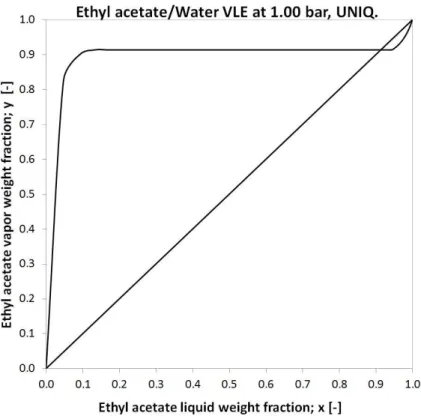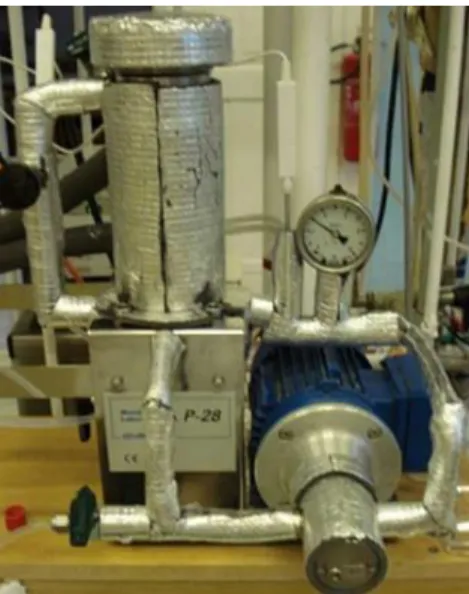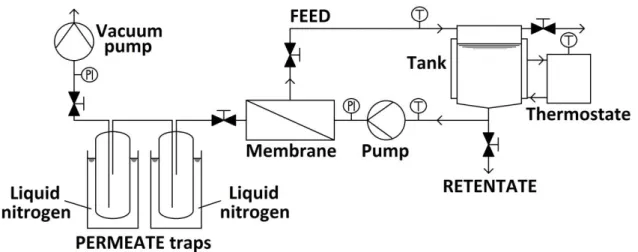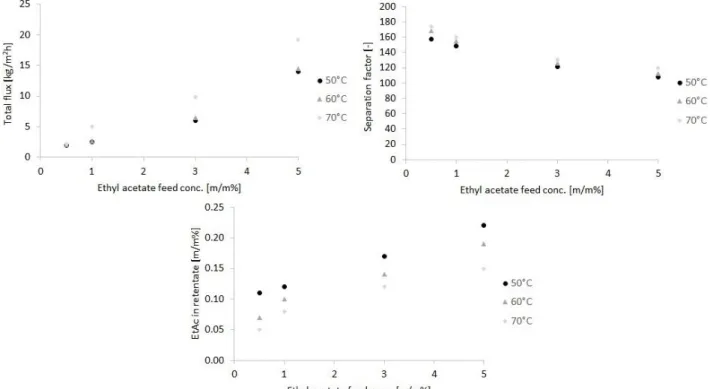Ethyl acetate removal from pharmaceutical process wastewater with organophilic pervaporation
A. J. Toth*, E. Haaz*, T. Nagy*, A. J. Tarjani*, D. Fozer* A. Andre* and N. Valentinyi*
* Environmental and Process Engineering Research Group, Department of Chemical and Environmental Process Engineering, Budapest University of Technology and Economics, H-1111, Hungary, Budapest, Műegyetem rkp. 3. (E-mail: andras86@kkft.bme.hu; haaz.e@kkft.bme.hu; tibor.nagy@kkft.bme.hu;
janka21@gmail.com, fozer.daniel@mail.bme.hu, anita.andre@mail.bme.hu, n.valentinyi@mail.bme.hu)
Abstract
The work is motivated by an industrial environmental problem, which is ethyl-acetate removal from process wastewater. In order to complete this goal, organophilic pervaporation of ethyl- acetate/water mixture through commercially available Sulzer PERVAP™ 4060 membrane is investigated. The experimental results are obtained at different feed concentrations (0.5–5 m/m%
ethyl-acetate) and temperatures (50–70°C). Our experimental data are evaluated with the pervaporation model (Valentínyi et al. 2013) of our improvement and it is found that the model can be applied also for this organophilic case. According to our measurements, ethyl-acetate content of process wastewater can be reduced under 0.05 m/m%. It can be determined this model can be applied in professional flowsheet environment and treatment of process wastewater can be rigorously designed.
Keywords
Process wastewater; Pervaporation; Ethyl acetate removal; Modelling
INTRODUCTION
The industrial application of pervaporation membrane separation has been increasing in recent decades, thanks to traditional separation techniques (distillation, absorption, etc.), while ensuring lower energy consumption and high selectivity. One of the main areas of application of liquid mixtures is the dehydration of the various aqueous azeotropic solvent mixtures. Separation can be carried out without the addition of an extra component, the recovered solvent and process wastewater can be recycled, so that pervaporation is an environmentally friendly process.
Large amount of process wastewater is generated by the pharmaceutical industry with methanol (MeOH) – ethyl acetate (EtAc) – water content. The separation of this ternary mixture is quite difficult, because it has complex, highly non-ideal vapour-liquid equilibria (see Table 1).
Table 1 Azeotrope types of MeOH-EtAc-Water mixture
Boil. T. Component (1) Component (2)
(1) (2) Type [°C] [m/m%] [m/m%]
EtAc MeOH homo 62.3 53.2 46.8
Water EtAc hetero 70.4–72.3 7.9–8.6 91.4–92.1
As it can be seen EtAc forms with MeOH minimal boiling homogeneous azeotropic mixture and Water-EtAc is heterogeneous azeotropic mixture. The ternary mixture can be separated into two binary azeotropic pair with extractive heterogeneous-azeotropic technique (Szanyi et al. 2004a, b, 2005; Toth et al. 2016a; Toth et al. 2016b; Toth et al. 2017) (see Figure 1).
Figure 1 EHAD technique (Toth et al. 2016a)
The bottom product is MeOH-Water binary mixture, that can be treated further with conventional distillation techniques. The separation of distillate, which is EtAc-Water binary mixture, can not be solved with simple distillation. Ethyl acetate can be removal from water with pressure swing distillation (PSD) or with organophilic pervaporation.
The actual task of this research is to investigate organophilic pervaporation in order to separate ethyl-acetate-water mixture. The vapour-liquid equilibrium of EtAc-Water can be seen in Figure 2 (UNIQUAC model).
Figure 2 Vapour-liquid equilibrium of EtAc-Water mixture
Organophilic pervaporation is able to removal volatile compounds from water. The PDMS is among the most interesting and promising membranes for organophilic pervaporation and it has been extensively investigated (Almquist & Hwang 1999; Yeom et al. 1999; Bakhshi et al. 2006b).
Pervaporation can be characterized by certain quantities and factors. The flux is calculated using the following equation (Huang et al. 2014):
(1) where Pi is the partial weight of component i in the permeate, t is the time of duration of experiment and A is the membrane area. Separation factor is calculated by the following equation:
(2) where α is separation factor (dimensionless), xi is weight fraction of ethyl acetate in feed and yi is weight fraction of ethyl acetate of permeate (Toth et al. 2015).
An essential tool for designing and optimizing separation processes is the appropriate computer modelling, which as accurate as possible model is needed (Rautenbach et al. 1990; Baker 2012;
Luis & Van der Bruggen 2015). Model parameter estimation is achieved using laboratory experiments.
MATERIAL AND METHODS
The experimental set-up is a P-28 membrane unit from CM-Celfa Membrantechnik AG (see Figure 1 and Figure 2). The flat sheet membrane with 28 cm2 effective area is placed on a sintered disc separating the feed and the permeate sides. Cross-flow circulation velocity is kept at a permanent value of ∼182 l/h (Toth & Mizsey 2015).
Figure 3 Photo of CM-Celfa Membrantechnik AG P-28 universal test membrane apparatus (Toth 2015)
Figure 4 Schematic figure of CM-Celfa P-28 pervaporation unit (Toth & Mizsey 2015) The vacuum on the permeate side is maintained with VACUUMBRAND PC2003 VARIO vacuum pump and kept at 2 Torr (2.67 mbar). The isotherm conditions are assured with a thermostate and monitored with thermometers at the inlet and outlet of the unit. The permeate is collected in two traps connected in series and cooled with liquid nitrogen to prevent loss of the permeate. The ethyl acetate content is measured with Shimadzu GC-14B gas chromatograph. The water content of organophilic experiments are measured with Hanna HI 904 coulometric Karl Fischer titrator (Toth et al. 2015).
The pervaporation experiments are carried out at different temperatures (50; 60; 70°C) and feed ethyl acetate concentrations (0.5; 1; 3 and 5 m/m%) to investigate the temperature and concentration dependence of the organophilic pervaporation process. Sulzer PERVAP™ 4060 PDMS polymeric membrane is used for pervaporation experiments.
According to the methodology of Valentínyi et al. (2013) the pervaporation can be described with the following semi-empirical model:
(3)
The model is an improvement of Rautenbach’s model (Rautenbach et al. 1990) and it considers the concentration dependencies of the transport coefficient. Four parameters of this model are estimated based on our measured data: transport coefficients (Di), permeability coefficients (Q0), activation energies (Ei) and B parameter. The estimations are completed with the STATISTICA® program environment.
RESULTS AND DISCUSSION
Figure 5 shows the effect of feed concentration on the pervaporation performance of the PERVAP™ 4060 membrane at different operating temperatures. As expected, the total flux is higher in the case of higher feed ethyl acetate contents. The total permeation flux through PERVAP 4060 membrane is found to vary from 2.0 to 19.2 kg/m2h and through PERVAP 4060 membrane over a concentration range of 0.5–5 m/m% at 50–70°C. It can be seen that increasing the ethyl acetate concentration increases the ethyl acetate permeation flux at higher temperatures.
The separation factor is greater for ethyl acetate under 1 m/m% feed concentration. A maximum separation factor of 174 can be observed at a feed concentration of 0.5 m/m%. At higher ethyl acetate composition, the separation capability of the membrane is declining.
A possible reason is that increasing the ethyl acetate concentration increases ethyl acetate sorption through the membrane (Oh et al. 2001; Mohammadi et al. 2005), and as a result, the membrane
becomes more swollen owing to its organophilic feature. The swollen membrane because of its increased free volume facilitates the diffusion of water through the membrane resulting in decreasing separation factor (Bakhshi et al. 2006a; Toth et al. 2015; Toth & Mizsey 2015).
Figure 5 Experiments results of ethyl acetate removal from water with organophilic pervaporation Figure 6 shows the comparison of experimental and modelled fluxes.
Figure 6 Measured partial fluxes of water and ethyl-acetate compared to fluxes calculated with model in a function of feed ethyl-acetate content at 70°C
Generally, it can be concluded that the model (Valentínyi et al. 2013) with the concentration dependency of the transport coefficient fit for the pervaporation measurements in a wide concentration range of the feed flow, particularly in the case Sulzer PERVAP™ 4060 (Toth &
Mizsey 2015).
SUMMARY
The results of parameter estimation and modelling of the pervaporation show that the model that considers the concentration dependency of the transport coefficient is also capable for the modelling of organophilic pervaporation and results in good fit to the experimental data. Our measurements are promising, because EtAc content can be reduced under 0.05 m/m%.
ACKNOWLEDGEMENT
The authors would like to acknowledge the financial support of János Bolyai Research Scholarship of the Hungarian Academy of Sciences and OTKA 112699 project. This research was supported by ÚNKP-17-3-I New National Excellence Program of the Ministry of Human Capacities.
REFERENCES
Almquist C. B. and Hwang S. T. (1999). The permeation of organophosphorus compounds in silicone rubber membranes. Journal of Membrane Science 153(1), 57-69.
Baker R. W. (2012). Membrane Technology and Applications. Wiley.
Bakhshi A., Mohammadi T., Nik O. G. and Aroujalian A. (2006a). Effect of operating conditions on pervaporation of methanol-water mixtures: Part 2. Membrane Technology 2006(12), 7-11.
Bakhshi A., Mohammadi T., Nik O. G. and Aroujalian A. (2006b). Effect of operating conditions on pervaporation of methanol-water mixtures: Part 1. Membrane Technology 2006(11), 7-9.
Huang B., Liu Q., Caro J. and Huang A. (2014). Iso-butanol dehydration by pervaporation using zeolite LTA membranes prepared on 3-aminopropyltriethoxysilane-modified alumina tubes.
Journal of Membrane Science 455(0), 200-6.
Luis P. and Van der Bruggen B. (2015). 4 - Pervaporation modeling: state of the art and future trends. In: Pervaporation, Vapour Permeation and Membrane Distillation, Woodhead Publishing, Oxford, pp. 87-106.
Mohammadi T., Aroujalian A. and Bakhshi A. (2005). Pervaporation of dilute alcoholic mixtures using PDMS membrane. Chemical Engineering Science 60(7), 1875-80.
Oh H. K., Song K. H., Lee K. R. and Rim J. M. (2001). Prediction of sorption and flux of solvents through PDMS membrane. Polymer 42(14), 6305-12.
Rautenbach R., Herion C. and Meyer-Blumentoth U. (1990). Pervaporation membrane separation processes. Membrane Science and Technology Series 1, 181-91.
Szanyi A., Mizsey P. and Fonyo Z. (2004a). Novel hybrid separation processes for solvent recovery based on positioning the extractive heterogeneous-azeotropic distillation. Chemical Engineering and Processing: Process Intensification 43, 327-38.
Szanyi A., Mizsey P. and Fonyo Z. (2004b). Optimization of nonideal separation structures based on extractive heterogeneous azeotropic distillation. Industrial and Engineering Chemistry Research 43, 8269-74.
Szanyi A., Mizsey P. and Fonyo Z. (2005). Separation of highly non-ideal quaternary mixtures with extractive heterogeneous-azeotropic distillation. Chemical and Biochemical Engineering Quarterly 19(2), 111-21.
Toth A. J. (2015). Liquid Waste Treatment with Physicochemical Tools for Environmental Protection. PhD Thesis, Budapest University of Technology and Economics, Budapest.
Toth A. J., Andre A., Haaz E. and Mizsey P. (2015). New horizon for the membrane separation:
Combination of organophilic and hydrophilic pervaporations. Separation and Purification Technology 156(2), 432–43.
Toth A. J., Haaz E., Nagy T., Tari R., Tarjani A. J., Fozer D., Szanyi A., Koczka K.-A., Racz L., Ugro G. and Mizsey P. (2017). Evaluation of the accuracy of modelling the separation of highly
non-ideal mixtures: extractive heterogeneous-azeotropic distillation. In: Computer Aided Chemical Engineering Espuña A, Graells M and Puigjaner L (eds), Elsevier, pp. 241-6.
Toth A. J. and Mizsey P. (2015). Methanol removal from aqueous mixture with organophilic pervaporation: Experiments and modelling. Chemical Engineering Research and Design 98, 123-35.
Toth A. J., Szanyi A., Angyal-Koczka K. and Mizsey P. (2016a). Enhanced Separation of Highly Non-ideal Mixtures with Extractive Heterogeneous-azeotropic Distillation. Separation Science and Technology 51(7), 1238–47.
Toth A. J., Szanyi A., Haaz E. and Mizsey P. (2016b). Separation of process wastewater with extractive heterogeneous-azeotropic distillation. Hungarian Journal of Industry and Chemistry 44(1), 29-32.
Valentínyi N., Cséfalvay E. and Mizsey P. (2013). Modelling of pervaporation: Parameter estimation and model development. Chemical Engineering Research and Design 91(1), 174-83.
Yeom C. K., Kim H. K. and Rhim J. W. (1999). Removal of trace VOCs from water through PDMS membranes and analysis of their permeation behaviors. Journal of Applied Polymer Science 73(4), 601-11.




